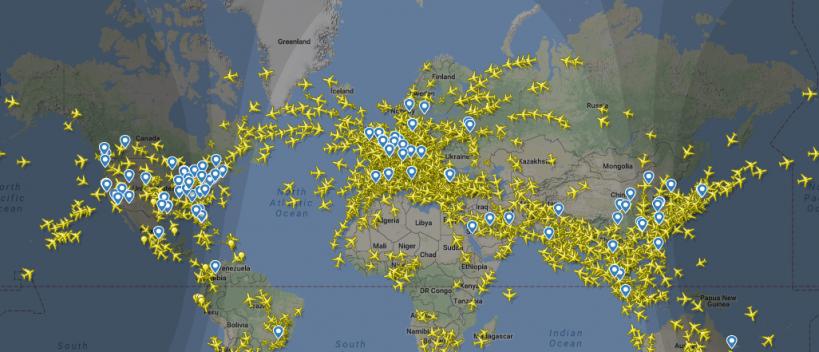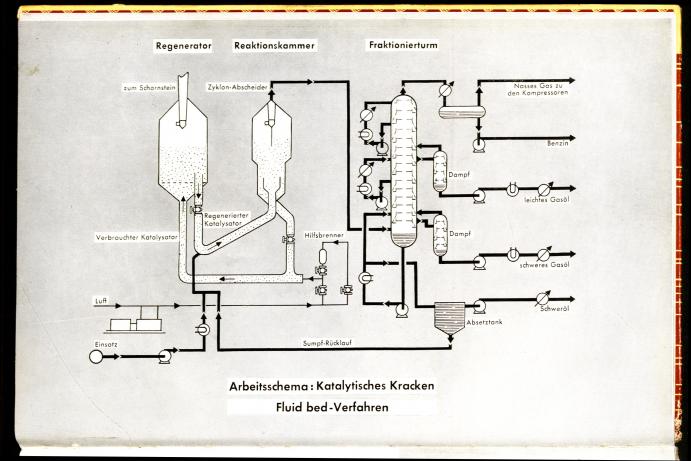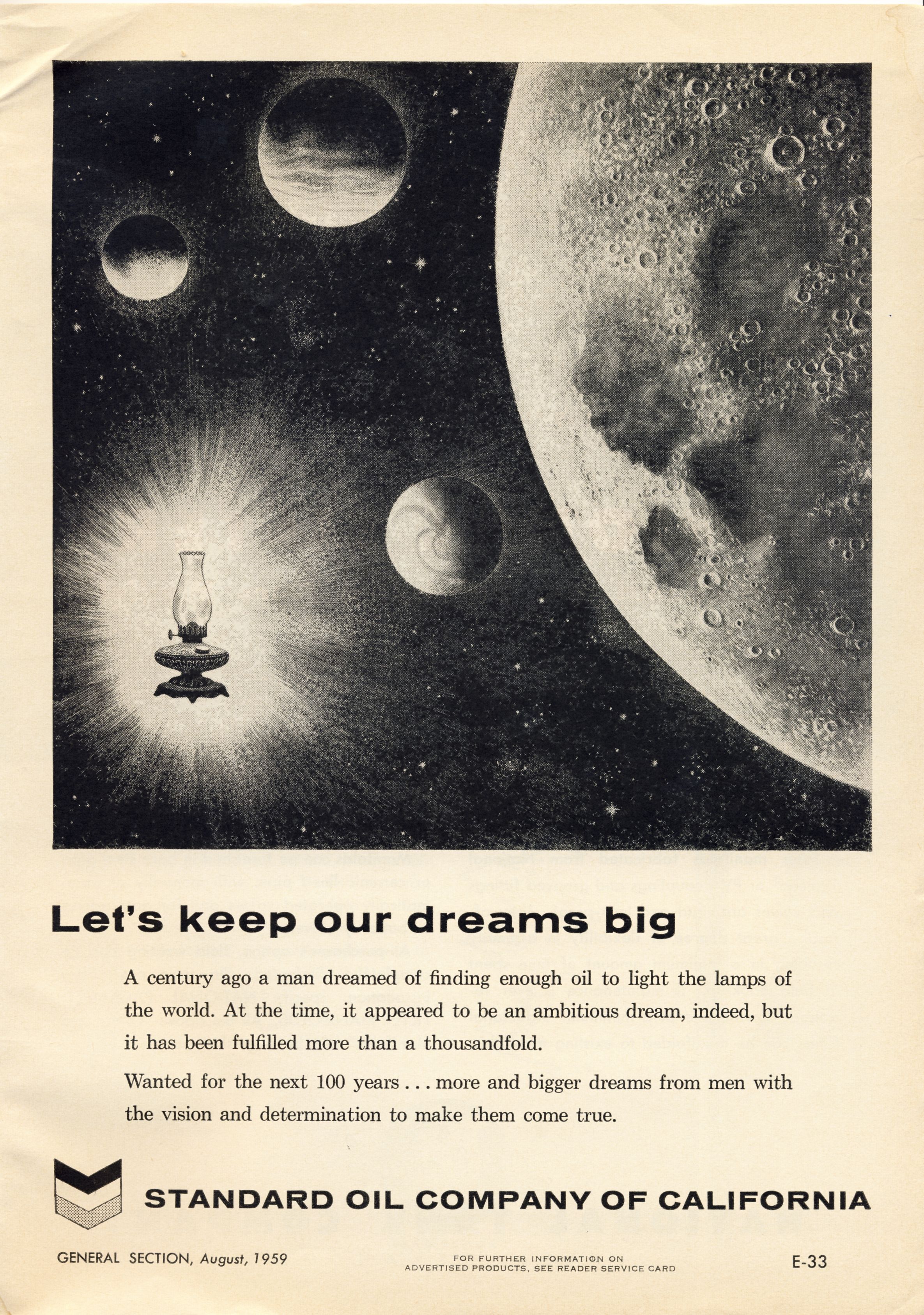
Global air traffic is one of the most obvious and significant features of petromodernity: real-time simulation from Flightradar24.com. Source: Flightradar24.com.
Exchange and Expansion: A Fossil-ecological System
The products of petrochemistry reach deep into our modern lifestyle: fuels and basic materials for pharmaceuticals, cosmetics, and all forms of plastics. From above we can see yet another, less obvious but equally existential branch of this industry. On the north side of the Maas/Rhine River lies Westland, “glass city,” one of the largest greenhouse regions in Europe. Both the landscape and atmosphere in which these famous Dutch tomatoes, cucumbers, and lettuces grow are artificial. In the greenhouses the concentration of carbon dioxide, which plants normally draw from the air, is artificially aerated. For some years now this carbon dioxide has been coming from the port’s refineries, just like the waste heat used for tempering the “glass city,” through a dedicated pipeline system of several hundred kilometers.
Fossil materiality thus not only drives engines and technical metabolisms, but becomes an immediate part of human metabolisms. The regular metabolism between animals and plants, the exchange of carbon dioxide and oxygen in closed cycles, and the deep evolutionary connection of humans to fire are decisively expanded when carbon from deep natural history is incorporated into current organisms. The growth of plants and subsequently of human beings becomes recognizable as a kind of subsystem to industrial petrochemistry, when harbor, refineries, and greenhouses coalesce into a fossil-ecological system.

A key unit of all petrochemical process landscapes: a Fluid Catalytic Cracking (FCC) unit. The first fluidized bed reactor (FBR) to process petroleum by a stream of circulating catalyst powder was built as a result of cooperation betweenStandard Oil, Shell, and I.G. Farben (among other companies) in 1942 in Baton Rouge, Louisiana. Source: Gerhard H. Lehmann, ABC des Erdöls, Erdöl-Spaltung. Die Shell Bücherei, Band 5 Heidelberg (1955), p. 24.
Complex Interconnections: Chemical Catalysis and Historical Processes
One of the most important features visible on the aerial depiction of the port are the refineries. Here, crude oil is transformed from a natural substance into a propellant of technology. Chemical catalysis, which has become an essential tool of petrochemical technology in the first decades of the twentieth century, provides for the acceleration and control of chemical reactions. With the help of metallic catalysts, molecules are cracked, hydrogenated, aromatized, reformed, and cyclized in order to produce “science-fashioned molecules,” as a Standard Oil advert put it in 1946. This form of molecular mobilization is a central component in the dynamics of the Anthropocene: no “Great Acceleration” without chemical acceleration.
Petroleum-based fuels and materials are necessary preconditions for modern mobility—and warfare, and thus of the historical process of modernity. And the desired forms of transport (or destruction) are only one aspect of their impact. Entire ecosystems are transformed as a collateral effect of motorized traffic, such as is the case with highway infrastructures in densely-populated areas or with the shipping traffic through the Suez Canal, which has radically changed the biodiversity of the Mediterranean Sea.
Another influence on biodiversity is agrochemistry. Not only the greenhouses of “glass city,” but also all types of open-air agriculture, are closely connected to petrochemistry. Artificial fertilizers, synthesized from hydrogen out of natural gas and nitrogen from the atmosphere, connect agriculture and the global biosphere with the reactors of petrochemical plants. What might appear as a contained chemical process in a refinery affects through its products the open processes of human and natural history. Because chemically-manipulated molecules are a basis for economic and political power, the scientific resources are provided to further explore and mobilize fossil molecules. This, therefore, is a self-enhancing system.
The history of the catalysis industry provides particularly dense examples of these connections. At the beginning of the twentieth century, the development of ammonia synthesis with artificial multicomponent catalysts and high-pressure reactors came as the result of geostrategic issues: the role of synthetic ammonia both for fertilizer and ammunition production. Planetary politics evoked innovations on the micro-chemical level, which then in turn would open—via synthetic ammunition in World War I—a new chapter in history.

Advertisement to celebrate 100 years of the US Oil Industry in 1959. The rational order and sciences of the twentiethcentury were shaped by the constant influx of fossil energy just as much as planetary technology was. Today, to "keep our dreams big" means to become aware of and to emancipate ourselves from this form of fossil enlightenment. Source: The Petroleum Engineer: Drilling & Production 31 (August 1959), General Section, The Petroleum Engineer for Management, p. E33.
Petromodernity as a Historical Epoch
In the next historical step, the geopolitics of fuel for motorization became crucial for the transfer of the technical platform of catalytic synthesis to the field of petrochemistry. The history of science is here much more than just academic history. In the 1920s and 1930s, industrial groups such as IG Farben, Standard Oil, and Shell enter the scene as powerful, well-financed, and historically very specific players in basic scientific research. In the case of Shell, for example, the history of a global colonial empire with extraction and refinery sites in Dutch Indonesia and the Dutch Caribbean contributes to the techno-scientific power of a global petroleum company.
Thus “Petromodernity” appears as an epoch in which all branches of science, technology, and everyday living cultures are deeply entangled with fossil resources. A whole rational order appears to be based on the economies, sciences, and politics of fossil resources: "fossil reason." This awaits both understanding and critique in epistemology and cultural theory, which is one aim of this project.
On the one hand, the fossil “energy regime” enables specific, modern ways of life and knowledge. On the other, the economic, energetic, and technological demands of precisely this "modern way of life" give reason to geologists and paleontologists to further investigate natural history in order to release its petrochemical and energetic potentials. Hard factors such as technology and industry, and so-called soft factors such as lifestyles, value systems, and cultural expectations, with political abysses and brutal injustices, are interconnected. The Anthropos appears as a “companion” of the fossil artificial molecules of petrochemistry. Even the "digital," often discussed as an escape from old and fossil industries, is deeply entangled with fossil energy and rationality. This topic needs further research in the areas of media theory and epistemology.
From an overhead Google Maps perspective, produced by a satellite launched into the sky using fossil fuels, everything appears connected in one great showcase. By taking an angle that is at once historical, geographical, and philosophical, this project seeks to dissect this wider picture and gain further insight into the disturbing mechanisms of petromodernity and its concrete and rational order.
